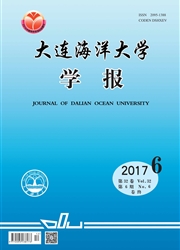

 中文摘要:
中文摘要:
在水温为9.0~16.0℃下,将体质量为(0.5±0.2)g的仿刺参Apostichopus japonicus Selenka幼参饲养在放置了混凝土制的中空型(A类)、楼层型(B类)和井字型(C类)附着基的塑料水槽(45 cm×31 cm×30 cm)中,投喂配合饲料,采用每周清洗一次附着基(A1、B1、C1组)和不清洗附着基(A、B、C组)的方法饲养80 d,研究了附着基形状及其处理方式对仿刺参幼参生长的影响。结果表明:是否清洗对仿刺参的特定生长率有极显著性影响(P〈0.01),附着基形状与是否清洗的交互作用对仿刺参的特定生长率有显著性影响(P〈0.05),其中B1组仿刺参的特定生长率最高,B组最低,且两组之间有显著性差异(P〈0.05);定期清洗附着基的各试验组水中氨氮和亚硝酸氮含量及化学耗氧量均低于不清洗组;不清洗附着基的各组仿刺参体腔液中超氧化物歧化酶(SOD)、酸性磷酸酶(ACP)和溶菌酶(LSZ)的平均活性分别比清洗组高32.28%、9.17%和5.71%,而相同形状附着基的不清洗组与清洗组仿刺参的SOD活性存在显著或极显著性差异(P〈0.05、P〈0.01)。
 英文摘要:
英文摘要:
Juvenile sea cucumber Apostichopus japonicus Selenka with body weight of(0.5±0.2)g was reared in tanks of each 45 cm×31 cm×30 cm in which three shapes of shelters including hollow cubic type(shelter A,group A),storied building type(shelter B,group B),and #-shaped type(shelter C,group C) were displaced at water temperature of 9.0-16.0 ℃ for 80 days with triplication to study the effects of shelter shapes on the growth of the sea cucumber.The tanks with the shelters were divided into two groups: one group in which the shelters were washed once a week(group A1,group B1 and group C1) and the other group in which the shelters were not washed(group A,group B and group C).The results showed that washing shelters or not have a very significant effect on the specific growth rate(SGR) of sea cucumber(P〈0.01),the interaction between cleaning shelters or not and the shapes of the shelters have a significant effect on the SGR of sea cucumber(P〈0.05).There was the maximal SGR in group B1 and the minimal SGR in group B,significant difference between the two group.There were lower nitrite,ammonia and COD levels in the water in the cleaned shelter tanks than those in the unwashed shelter tanks.There were 32.28% higher activity of superoxide dismutase(SOD),9.17% higher acid phosphatase(ACP) activity and 5.71% higher lysozyme(LSZ) activity in the coelomic fluid of the sea cucumber in the tanks with the uncleaned shelters than those in the sea cucumber in the tanks with the cleaned shelters.In all experimental groups,the activity of SOD in group A and group A1 was found to be very significantly different(P〈0.01),group B and group B1 significantly different(P〈0.05),group C and group C1 very significant difference(P〈0.01).
 同期刊论文项目
同期刊论文项目
 同项目期刊论文
同项目期刊论文
 期刊信息
期刊信息
